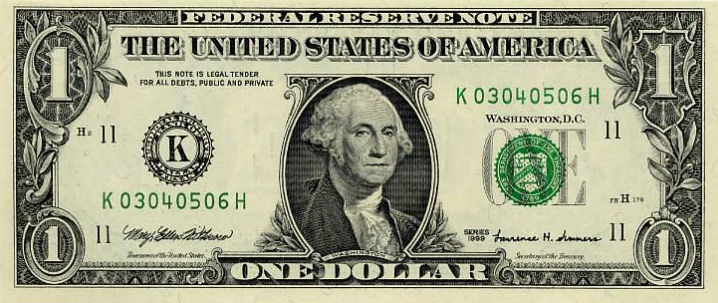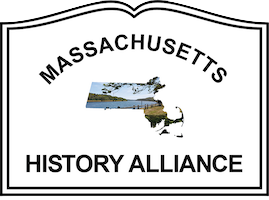Rack Focus: Bringing Northern Slavery into View by Elise Lemire — excerpt
2011 Mass History Conference Keynote Excerpt
Picture in your mind’s eye, if you will, an American one dollar bill. Whose image is on it? George Washington, right? I’m going to make you see someone else. I’m going to make you see someone else every time you take out a one dollar bill. To do this, I need you to think with me about what this portrait of Washington tells us about the man. It might not seem like the portrait tells us very much. He’s a white man. He’s not particularly young. His hair line has receded somewhat and his hair, which is tied back with a ribbon, is completely white. He’s wearing a beautiful ruffled linen shirt and a dark colored suit jacket. But he doesn’t appear particularly happy if you consider that his lips are firmly pressed together.
Let’s unpack these details. Most gentlemen in Washington’s era owned wigs, the wearing of which was a very complicated affair. A man had to shave his head regularly so the wig would fit. The wig itself, which was made of human or animal hair depending on how wealthy you were, had to be cleaned, oiled, and powdered so that it would be fashionably white. Washington didn’t shave his head, nor is he wearing a wig here, but
he did follow the fashion of the day by assiduously powdering his graying light brown hair.
What about that facial expression? George Washington lost all but one of his adult teeth in his twenties and thirties. In the 1780s, he compelled several of his slaves to have their teeth extracted so he could have their teeth implanted in his own jaw. When these didn’t take, Washington’s dentist made plates, fashioned out of hippopotamus ivory, into which he inserted, not the mythological wooden teeth, but a combination of human and animal teeth. These dentures were spring-loaded and Washington had to clamp down on them to keep them in his mouth. That’s what created the bulge you see around his mouth and the distortion of his jaw line.
Now for his attire. Obviously that shirt also speaks to Washington’s wealth and taste as a gentleman. But the suit says something else besides. Up until his inauguration, Washington had always appeared on the public stage in his military uniform. He switched to suits at the time of his first inauguration as a means of conveying the idea that a president is a citizen-leader, not a monarch. Washington also believed it was important to be seen in American-made textiles. He famously ordered a bolt of brown cloth from a manufactory in Hartford, Connecticut, to make this suit.
It’s conceivable that this suit was made by people Washington owned. He had a slave woman named Betty who he used exclusively as a lady’s maid and seamstress. He also had an indentured servant, Andrew Judge, who was an English-born tailor. In 1773, Betty and Andrew had a child together, a daughter named Oney, who grew up to be, in the President’s own words, a “perfect Mistress of her needle.” Picture Oney working in the President’s House in Philadelphia, then the nation’s capital. (The President’s House has recently become a museum dedicated in part to the story of Washington’s slaves.) By then, Oney is in her early twenties. She’s one of nine slaves the President has brought from his plantation in Virginia. Each has been carefully chosen to perform certain duties. It’s possible that one of Oney’s duties is to make the suit that the President wears when he sits for his portrait.
One day, Oney overhears a conversation that changes her life forever. She is going to be given as a wedding present to one of Martha Washington’s granddaughters. Learning this, something inside Oney clicks into place. She realizes she is very tired of other people dictating her future. Oney Judge runs away.
Three days later, President Washington puts an advertisement for Oney in the newspaper. He offers ten dollars to the person who can “bring her home.” And this is just the President’s opening gambit. He spends the next two years trying to recapture his seamstress, who by then has made her way to New Hampshire.
Years later, Oney Judge is asked by abolitionists if she regrets the poverty she has endured as a free woman. “No, I am free,” she replies, “and have, I trust been made a child of God by the means.”
So who do you see when you look at an American one dollar bill? You see a citizen leading the world’s first democracy. You also see a slaveholder. But now, behind that terrible contradiction, you see a young woman of great conviction and courage. You see Oney Judge.
To take the one dollar bill, something virtually all Americans see on a regular basis, and make it speak the story of slavery, I . . . focused your attention on the details, in this case George Washington’s smile and his plain dark suit. I contextualized those details. I asked you to reject the deeply American ideal of the self-made man. And finally I individualized the story of Washington’s over 400 slaves in order to personalize what would otherwise be dry facts and statistics. The result was a kind of rack focus. Your attention has been shifted from the plane our culture keeps in sharp focus, the first president of our nation, to the story behind his appearance of a young woman who was enslaved in the North. But you’ve also been asked to connect those two planes. Behind the wealthiest seemingly self-made American men our nation most reveres are often the slaves who provided them with status and labor.
